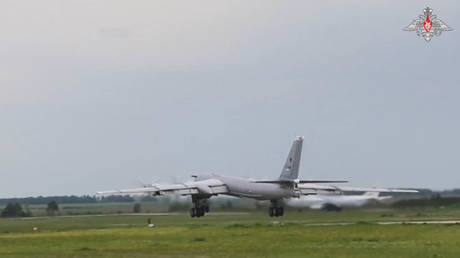China and Russia must keep a close eye on Japan
The resurgent militarism and US power projection through Tokyo are a danger to regional stability that could hinder the Eurasian powers

China and Russia must keep a close eye on Japan
By Timur Fomenko, a political analyst

On Tuesday, China and Russia conducted a joint air patrol over the Sea of Japan and the East China Sea.
It was the sixth such exercise since such joint flights began in 2019 and a routine part of the two countries’ plan of military cooperation. Japan, as well as South Korea, responded by scrambling their own fighter jets in response.
China and Russia are countries of vast size, and both powers are in a standoff with the United States and its proxies in various theatres, be it Ukraine in Europe or Taiwan in the South China Sea. The geographic space of Northeast Asia holds a unique position because it is the only region where China and Russia share a frontier with Japan. As Tokyo pushes itself towards American-supported remilitarisation, it has increasingly made itself an adversary of both Moscow and Beijing. Here, the two powers are working together against this resurgent US client.
The archipelago which makes up the territory of Japan is a critical outpost for American dominance over Asia, allowing for the projection of force directly onto the Eurasian continent targeting both China and Russia, as well as extending southwards into the critical “first island chain” along the continent’s eastern shores. Following the surrender of Japan to the US after World War II, America transformed the country into a vassal state to host its own forces amidst the emerging Cold War, establishing military bases on Japanese soil and using Japanese ports for US ships, including aircraft carriers.
However, as American priorities in Asia expand, the dynamic is changing. In addition to the existing US military presence, Washington has given Tokyo the green light to supersede its own constitutional limits and pursue a full-scale rearmament with a pledged long term increase of over 60% in defense spending. This, in turn, has been emboldened by military and historical revisionists for the Imperial era taking political ascendancy. With Japan being denialist and unapologetic of its WW2-era atrocities, the re-emergence of a nationalist and militarist Tokyo poses a threat to the entire region of Asia and raises the danger of an arms race against Russia and China.
Despite being a vastly integrated trading and economic partner with China, Tokyo now sees the rise of Beijing as a political and economic threat, as it stands to upend its power position in Asia. Similarly, as Japan becomes more militaristic, it is attempting to ‘globalize’ itself, becoming more closely integrated with the West. Hence, Prime Minister Fumio Kishida is eager to bring NATO influence into Asia. He visited Kiev the day Chinese President Xi Jinping visited Moscow, attended a NATO summit, and is lobbying for a NATO office to be opened in his country. Tokyo has thus made itself simultaneously antagonistic to both Moscow and Beijing.
Thus, neither China nor Russia wants to see a resurgent Japan who is inviting a NATO presence into the region. This has led to a dual “response” with Tokyo becoming a high-priority, mutually overlapping area of interest between Beijing and Moscow. Although the two countries have a “no-limits” strategic partnership, geography means that their individual priorities and areas of focus may differ. For example, what use is the South China Sea to Russia, which has no maritime presence there? However, in the sphere of North East Asia, there are no such differences, because the march towards Japanese rearmament, the expansion of NATO influence and US force projection poses the same risks for both countries. The Sea of Japan is essentially a communal backyard for them.
With this in mind, the alignment of China and Russia here is a balance-of-power arrangement. A third party the two countries could also see as ‘friendly’ in this specific region is North Korea, reviving memories of a long-gone Cold War era. Although Pyongyang’s nuclear and missile programs upend regional stability, enable Japanese rearmament and an increased US military presence in the South, its geographic value makes it an important military counterweight. In this new strategic environment, it is in the interests of neither country to adhere to US-led sanctions programs against the DPRK and to allow its containment. But in facing off against Washington here, it is obvious that Japan has become the primary military problem. In the long term, this is going to be a very volatile and tense region, and therefore Chinese-Russian military cooperation is critical to checking Japanese adventurism. However, the resulting arms race that will stem from it means regional security will continue to be a tightrope.
The statements, views and opinions expressed in this column are solely those of the author and do not necessarily represent those of RT.












